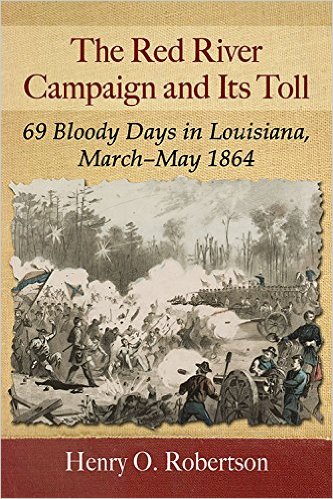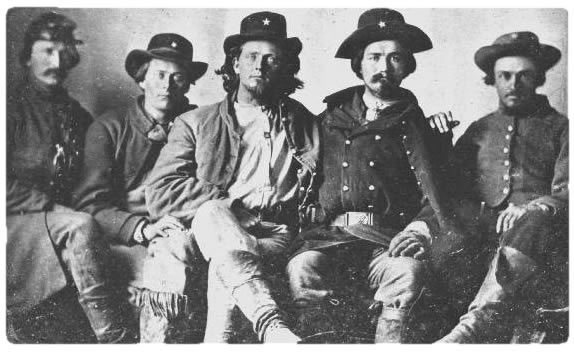The Red River Campaign and Its Toll: 69 Bloody Days in Louisiana, March-May 1864 by Henry O. Robertson. McFarland, 2016. Paper, ISBN: 978-1476663784. $29.95.
 In March 1864, Major General Nathaniel Banks led a combined force of roughly thirty thousand Union soldiers deep into the heartland of Louisiana. Their goal was to capture Louisiana’s Confederate capital city, Shreveport; destroy the rebel forces that confronted them; and confiscate the cotton that lined the length of their primary avenue of invasion—the winding waterways of the Red River. With these objectives successfully accomplished, pressure could then be applied to Confederate forces in Texas.
In March 1864, Major General Nathaniel Banks led a combined force of roughly thirty thousand Union soldiers deep into the heartland of Louisiana. Their goal was to capture Louisiana’s Confederate capital city, Shreveport; destroy the rebel forces that confronted them; and confiscate the cotton that lined the length of their primary avenue of invasion—the winding waterways of the Red River. With these objectives successfully accomplished, pressure could then be applied to Confederate forces in Texas.
What began propitiously soon devolved into fiasco. Ultimately, Banks and his army were confronted by seven thousand Confederate troops led by Gen. Richard Taylor and, on April 8, 1864, they clashed in a vicious and bloody battle at Mansfield. At Pleasant Hill, another battle followed this fight the very next day. Defeated by Taylor’s soldiers and by the geography of the Red River Valley, Banks’ force withdrew. By the conclusion of the campaign, the entire Union command had limped back to where they had started, and with comparatively little to show for it. For the Union Army, the Red River Campaign ended in disaster. Fighting and maneuvering in central Louisiana cost both armies nearly 10,000 combined casualties, and the military career of Nathaniel Banks came to a mercifully abrupt conclusion. For the southern Confederacy, the events of March, April, and May 1864 would provide one of their last decisive victories of the American Civil War. In writing of the Red River Campaign, William T. Sherman described it aptly as “one damn blunder from beginning to end.”
Not unlike the winding waterway upon which it unfolded, the history of the Red River Campaign has remained as murky as the water of the river itself. The seminal work on Gen. Nathaniel Banks’ failed endeavor, the 1958 Red River Campaign: Politics and Cotton in the Civil War by Ludwell Johnson, has now surpassed the half-century mark. Other notable works, primarily Michael Forsyth’s The Red River Campaign of 1864 and the Loss by the Confederacy of the Civil War, as well as several works by historian Gary D. Joiner, have tackled aspects of the fighting in central Louisiana. Yet there remain uncharted waters in Louisiana’s largest and most destructive Civil War campaign.
Into this void charges Henry O. Robertson’s The Red River Campaign and Its Toll: 69 Bloody Days in Louisiana, March – May 1864, an accessible and fast-paced account of those three months of fighting, marching, and maneuvering in Louisiana. Robertson does not attempt an exhaustive study of the campaign. What he does deliver, however, is an impressive, one-volume study that carries the reader swiftly from event to event, while simultaneously focusing on the social, political, and economic conditions in which the campaign was waged and which characterized Civil War era Louisiana. This is a well-researched and well-written book that, at times, transcends to eloquence. Most impressive is the author’s command and use of archival sources. Robertson, in researching and crafting his work, seems to have left few stones unturned.
As befitting a campaign study, the movements and strategies of the opposing armies on the battlefield and the not infrequent bungling of commanders is well chronicled. Readers hoping for a more exhaustive treatment of the Battles of Mansfield, Pleasant Hill, and the other major engagements of the campaign will perhaps be disappointed. The reader is carried speedily through the narrative, and while the importance of those engagements to the overall conclusion of the campaign is well described, little lingering is done. Yet the time Robertson devotes to tracing the pre-war and pre-campaign social history of the region more than makes up for it. This is a book about slaves, cotton, and politics as much as it is a book about battles. The result is a far richer and more satisfying campaign study than it otherwise might have been.
For those wishing for an overview of this underappreciated campaign, Henry O. Robertson’s is a worthy book. Succinct yet engaging, it breathes fresh life into one of the more obscure campaigns of the American Civil War.
Christopher Gwinn is Supervisory Park Historian at Gettysburg National Military Park. The views expressed herein are his, and do not represent those of the National Park Service.
